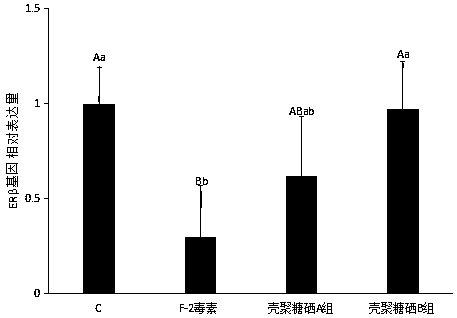Application of chitosan-Se in inhibiting reduction of ERbeta gene expression of epithelial cells of porcine endometrium caused by F-2 toxins
A technology of chitosan-selenium and endometrium, which is applied in the field of cell engineering, can solve the problems of reducing, not seeing chitosan-selenium, and not seeing the expression of ERβ gene in porcine endometrial epithelial cells
- Summary
- Abstract
- Description
- Claims
- Application Information
AI Technical Summary
Problems solved by technology
Method used
Image
Examples
Embodiment 1
[0020] 1.1 Isolation and purification of porcine endometrial cells
[0021] (1) Isolation of endometrial cells
[0022] Immediately after the slaughter of the pig, the two ends of the uterus were ligated, and the whole uterus was aseptically removed, the fat tissue was peeled off, rinsed with 200 IU double-antibody pre-cooled normal saline solution, placed in the double-antibody-containing normal saline solution, and sent to the hospital as soon as possible. to the lab. Clamp both ends of the uterus with hemostatic forceps, take out the uterus in the ultra-clean workbench, soak it in alcohol for about 60 seconds, wash it with PBS after taking it out; cut the uterus longitudinally (close to the uterine horn), wash it 3-4 times with double-antibody PBS, without Bloodstain, cut endometrium to 1 mm 3 Left and right granular, placed in the cell culture plate evenly at intervals of about 0.5 cm, after the tissue block was attached to the cell culture plate, add a small amount of c...
Embodiment 2
[0056] 2.1 Isolation and purification of porcine endometrial cells
[0057] (1) Isolation of endometrial cells
[0058] Immediately after the slaughter of the pig, the two ends of the uterus were ligated, and the whole uterus was aseptically removed, the fat tissue was peeled off, rinsed with 200 IU double-antibody pre-cooled normal saline solution, placed in the double-antibody-containing normal saline solution, and sent to the hospital as soon as possible. to the laboratory. Clamp both ends of the uterus with hemostatic forceps, take out the uterus in the ultra-clean workbench, soak it in alcohol for about 60 seconds, wash it with PBS after taking it out; cut the uterus longitudinally (close to the uterine horn), wash it 3-4 times with double-antibody PBS, without Bloodstain, cut endometrium to 1 mm 3 Left and right granular, placed in the cell culture plate evenly at intervals of about 0.5 cm, after the tissue block was attached to the cell culture plate, add a small amou...
Embodiment 3
[0092] 3.1 Isolation and purification of porcine endometrial cells
[0093] (1) Isolation of endometrial cells
[0094] Immediately after the slaughter of the pig, the two ends of the uterus were ligated, and the whole uterus was aseptically removed, the fat tissue was peeled off, rinsed with 200 IU double-antibody pre-cooled normal saline solution, placed in the double-antibody-containing normal saline solution, and sent to the hospital as soon as possible. to the lab. Clamp both ends of the uterus with hemostatic forceps, take out the uterus in the ultra-clean workbench, soak it in alcohol for about 60 seconds, wash it with PBS after taking it out; cut the uterus longitudinally (close to the uterine horn), wash it 3-4 times with double-antibody PBS, without Bloodstain, cut endometrium to 1 mm 3 Left and right granular, placed in the cell culture plate evenly at intervals of about 0.5 cm, after the tissue block was attached to the cell culture plate, add a small amount of c...
PUM
 Login to View More
Login to View More Abstract
Description
Claims
Application Information
 Login to View More
Login to View More - R&D
- Intellectual Property
- Life Sciences
- Materials
- Tech Scout
- Unparalleled Data Quality
- Higher Quality Content
- 60% Fewer Hallucinations
Browse by: Latest US Patents, China's latest patents, Technical Efficacy Thesaurus, Application Domain, Technology Topic, Popular Technical Reports.
© 2025 PatSnap. All rights reserved.Legal|Privacy policy|Modern Slavery Act Transparency Statement|Sitemap|About US| Contact US: help@patsnap.com



